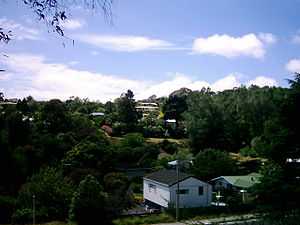Havelock North
| Havelock North | ||
|---|---|---|
 Havelock North | ||
| Urban Area | Resident Population | 12,360 (2011)[1] |
| Regional Council |
Hawke's Bay | |
Havelock North is a suburb in Hastings, New Zealand, in the North Island's Hawke's Bay region. It ranked as a borough for many years until the 1989 reorganisation of local government saw it merged into the new Hastings District.
Location, features and population
The suburb, known locally as "the village", stands on the Heretaunga Plains, and has a reputation for its orchards, vineyards, and educational facilities. One of New Zealand's most important wine regions spreads around the area. The town's industry is based around its fruit and wine production, and includes a horticultural research centre.
Havelock North is situated at the base of the prominent landmark Te Mata Peak, a 399-metre outcrop, which according to local Māori legend is the body of a giant, Te Mata o Rongokako.
One of the town's most impressive buildings is Whare Ra, a house built for a temple of the Hermetic Order of the Golden Dawn in the early twentieth century.
Havelock North is generally hilly, as it is on the foothills of Te Mata Peak and small gullies have been formed by the creeks and streams flowing from Te Mata Peak, resulting in a small amount of inaccessible or steep land which is converted into forests, parks or reserves, giving the image of naturally having many bushes and trees.
Areas within Havelock North include Anderson Park, Iona, Havelock North Central, Te Mata and Te Mata Hills, from the census units of Statistics NZ.[2]
History


Havelock North took its name from Sir Henry Havelock, a hero of the Indian Mutiny campaign, thus keeping with the local habit of naming towns after prominent men from Imperial India. Its founders originally envisaged a larger town for the site, but when the Wellington-Napier rail line went through the area in 1874 it took a direct route some distance from Havelock North, and Hastings became a more logical choice for residents
Like a number of North Island towns, Havelock North has grown larger than its South Island namesake, Havelock, in the Marlborough Sounds.
Residents
Notable residents include:
- Alan Duff (born 1950), novelist
- Alfred Meebold (1863–1952), botanist, writer, and anthroposopher (died at Havelock North)
- Dr Robert William Felkin (1853–1926), medical missionary, ceremonial magician, author on Uganda and Central Africa, explorer, and early anthropologist
Many of Havelock North's residents are those who commute to downtown Hastings or Napier who prefer rural or suburban life.
Education
The town is better-endowed educationally than many of its size.
It has Taruna College for teacher training, based on Rudolph Steiner principles.
Havelock North Intermediate School is a district leader in Media Studies, with pupils from Hastings visiting it for classes.
Other schools also include Te Mata Primary, Havelock North Primary, Lucknow Primary and Havelock North High School as well as the private schools Hereworth, Woodford House and Iona College.
References
External links
| Wikivoyage has a travel guide for Havelock North. |
| Wikimedia Commons has media related to Havelock North, New Zealand. |
Coordinates: 39°40′S 176°53′E / 39.667°S 176.883°E